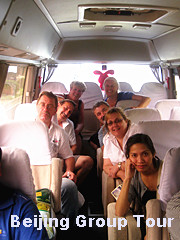 Banpo Neolithic Village Museum
Banpo Neolithic Village Museum
 |
Six to seven thousand years ago, late Neolithic people built a stable village. Banpo had about 500 people living in the village. |
 Visitors today can see the remains of 45 houses, 2 stables, more than 200 cellars, 6 kilns, and about 250 graves. It was a matriarchal society based on farming. The houses were constructed of thatch over wood beams while the floors were sunk two to three feet into the ground. Heat was provided by a central fire. Food was stored in underground caves, dug deep enough to protect the provisions from being devoured by wildlife or contaminated by insects. Architecture, village organization, and food storage methods appear to have been strikingly similar to the way of life of some Native American plains tribes.
Visitors today can see the remains of 45 houses, 2 stables, more than 200 cellars, 6 kilns, and about 250 graves. It was a matriarchal society based on farming. The houses were constructed of thatch over wood beams while the floors were sunk two to three feet into the ground. Heat was provided by a central fire. Food was stored in underground caves, dug deep enough to protect the provisions from being devoured by wildlife or contaminated by insects. Architecture, village organization, and food storage methods appear to have been strikingly similar to the way of life of some Native American plains tribes.
The Banpo worked together. They dug a trench around the entire complex both for protection and for drainage. There was a large meeting hall in the center of the village and a place for central storage. Most of the tools (e.g., axes, hoes, knives) were of stone, but some implements were of bone (e.g., needles for sewing). The stone tools look remarkably sharp, but it was still fortunate that the Banpo settled in an area where the soil was loose and easily tilled.
Art, in the form of geometric designs and human and animal figures, is found on many of the pots. Some of the pottery items have marks scratched on them that may well anticipate a form of writing. The village pottery produced specialized pots for drinking, storage, cooking, and burial. (Although adults were buried in the cemetery outside the village, children and infants were buried alongside the huts in special clay urns; the reason for this continues to be matter for speculation.)
Over the next 3000 years, the descendants of the Banpo people founded new villages, began to build cities, used jade, bronze, and copper, and increased their skills in agriculture. The first dynasty (or unified government) was called the Xia and lasted from approximately 2200 B.C. to 1700 B.C. Life changed more rapidly after that time--or so it appears from our modern-day perspective.
China Attractions
- Beijing Attractions
- Shanghai Attractions
- Xian Attractions
- Guilin Attractions
- Guangzhou Attractions
- Lhasa Attractions
- Yangshuo Attractions
- Hangzhou Attractions
- Nanjing Attractions
- Huangshan Attractions
- Wuhan Attractions
- Dali Attractions
- Harbin Attractions
- Suzhou Attractions
- Kunming Attractions
- Pingyao Attractions
- Xinjiang Attractions
- Kashgar Attractions
- Chengdu Attractions
- Sanya Attractions
- Lijiang Attractions
- Datong Attractions
- Dunhuang Attractions


